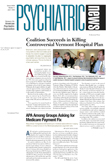How does fear get a grip on the dark inner resources of a person’s mind? By switching on nerves in a primitive part of the brain called the amygdala, a new animal study suggests. The amygdala has already been implicated in fear in both animals and humans.
The study was conducted by Vadim Bolshakov, Ph.D., of McLean Hospital in Belmont, Mass., other McLean scientists, and Eric Kandel, M.D., a professor of psychiatry at Columbia University. Kandel won a 2000 Nobel Prize in Medicine for his discoveries of how the efficiency of nerve synapses can be modified and which molecular mechanisms take part in that modification (Psychiatric News, November 3, 2000).
First Bolshakov, Kandel, and their colleagues trained rats to fear a sound. They then stimulated individual neurons in the rats’ amygdalas at a very high frequency. Normally during high-frequency stimulation, presynaptic neurons in the amygdala release the nerve transmitter glutamate. The glutamate then causes postsynaptic neurons in the amygdala to produce an enduring increase in electric current. But in the postsynaptic neurons of these fear-conditioned rats, current output barely increased above baseline levels. This finding suggested that the presynaptic neurons had already been stimulating the postsynaptic neurons as a result of fear conditioning. In short, fear seems to have already switched on nerves in the rats’ amygdalas so that any subsequent stimulation wouldn’t have much of an impact on them.
This finding may also lead to a better understanding of human anxiety disorders, the researchers believe. “The study of learned fear in laboratory animals is likely to provide a new generation of antianxiety agents that will be very useful,” Kandel predicted in a press release from McLean Hospital.
But this experiment may also be the first strong evidence that learning or memory of any kind can lead to long-term potentiation of brain neurons—that is, to a prolonged heightened response of postsynaptic neurons. Although there have been a number of attempts to demonstrate “a causal interaction between the two, I think that this is the first really important causal link,” Kandel asserted in the press release.
The study by Bolshakov, Kandel, and their colleagues is reported in the April 11 Neuron.
A summary of the study, “Fear Conditioning Occludes LTP-Induced Presynaptic Enhancement of Synaptic Transmission in the Cortical Pathway to the Lateral Amygdala,” is posted on the Web at www.neuron.org/cgi/content/abstract/34/2/289/. ▪
